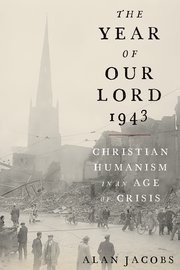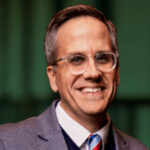Often those who write about the past have trouble showing why looking back is of value for present and future living. Yet, the authors who write well know how to illuminate the past simply by showing how bygone ages contrast with our own. In the contrast, illumination shines and reflection ensues. Alan Jacobs excels at this in his latest book, The Year of Our Lord 1943.
What causes one to marvel when reading this book is a quick awareness of how different is the Western world 75 years removed. Since we maintain a strong connection to the World War II-era in literature and films, one can think he knows the era well, or even think that era is not that different from our own. Jacobs, however, quickly shows the contrast. For, he says, the 1940s was a decade “when prominent Christian thinkers in the West believed that they had a responsibility to set a direction not just for churches but for the whole of society. And, stranger still, in that time, many of their fellow citizens were willing to grant them that authority—or at least listen when they asserted it” (xi). Indeed, we’ve come along way since then.
Jacobs weaves those figures that acted on their beliefs into a beautiful narrative that follows, uniquely, an Orson Welles directorial technique. Jacobs focuses first on an individual and then shifts to another at the point where their ideas connect, which leads him to a third, only to welcome the return of the first. Jacobs’s “camera” follows their ideas and themes rather than their conversations. In this, Jacobs too, is a director, and as good directors are wont to do, he captures the light of his subject for the illumination of his readers. The result is the likes of Jacques Maritain, T. S. Eliot, C. S. Lewis, W. H. Auden, and Simone Weil enter and exit this book to provide a commentary for the present.
Jacobs’s first two chapters provide an assessment of why these authors felt the need to act in an era of world war. First, they sought to provide answers for a populace beleaguered and dismayed by the war and the effects of war. Second, regardless of the outcome, they wanted to bolster a new generation to know and to have answers to ultimate questions. How did they do this? This book is Jacobs’s portrait of these “wartime Christian thinkers” and their presentation of a Christian humanism that included, but also went beyond, theological and philosophical presentations. In particular, they sought to infuse literature and the arts with their Christianity to recapture Western Civilization. And, as Jacobs shows and argues, herein lies the example for the present for, he says, “through these practices, which I believe are best called ‘humanistic,’ that the renewal—or if necessary the revolutionary upheaval—of Western civilization will be achieved” (50).
Jacobs task of illuminating “humane learning as a force for social renewal” tracks Lewis’s sermon at Oxford’s University Church, “Learning in War-Time.” He notes that Lewis’s “academic training as a medievalist is not, in his mind, an irrelevance, still less an impediment, but a qualification for social commentary” (62). In our own “everyone is an expert” era, Jacobs’s portrait of these scholars in this way is one of the brightest areas of contrast. These who have read and thought and prepared are the ones qualified to give social commentary. This is neither a plea for elitism nor a critique of egalitarianism, but rather recognition that the culture often needs instruction from experts to direct them away from making the mistakes of those who have failed to heed such advice. As Lewis trumps, “the scholar has lived in many times and is therefore in some degree immune from the great cataract of nonsense that pours from the press and the microphone of his own age” (62).
Jacobs also presents Simone Weil’s defense of the value of the study of the past for the present. In her reflections on the Iliad—again don’t miss the value here of a thinker offering thoughts for the present developed from reading and thinking through great works of the past—Weil asks,
Why dwell upon the past, instead of directing one’s thoughts to the future? If people are turning, for the first time in hundreds of years, to contemplate the past is this because we are weary and close to despair? Indeed we are so (94). Then Director Jacobs guides the reader to see that “we must turn to the past, not because it is necessarily better than our own world, but because it is different” (95).
The Year of Our Lord 1943 continues to explore the implications of these thoughts for the culture then and for the culture now. Jacobs shows that the project of these wartime Christian thinkers was and is an aid, actually, to the development of democracy. Rather than seeing Christianity and Democracy at odds, these thinkers saw Christianity sustaining and protecting democracy by serving as its conscience (188).
These thoughts are needed in our day, perhaps now more than ever. There is a reason why The Wall Street Journal listed Jacobs’s book as one of their best books on politics in 2018. For Jacobs’s narrative of the contributions of past Christian thinkers also serves well as an example of a contemporary contribution of a Christian thinker to whom the current culture should listen. Jacobs, following Lewis, is in some degree immune from the great cataract of nonsense that pours from the microphones and platforms of our age. Readers who spend time with this book will find themselves stopping to think, and in the thinking will come illumination.










